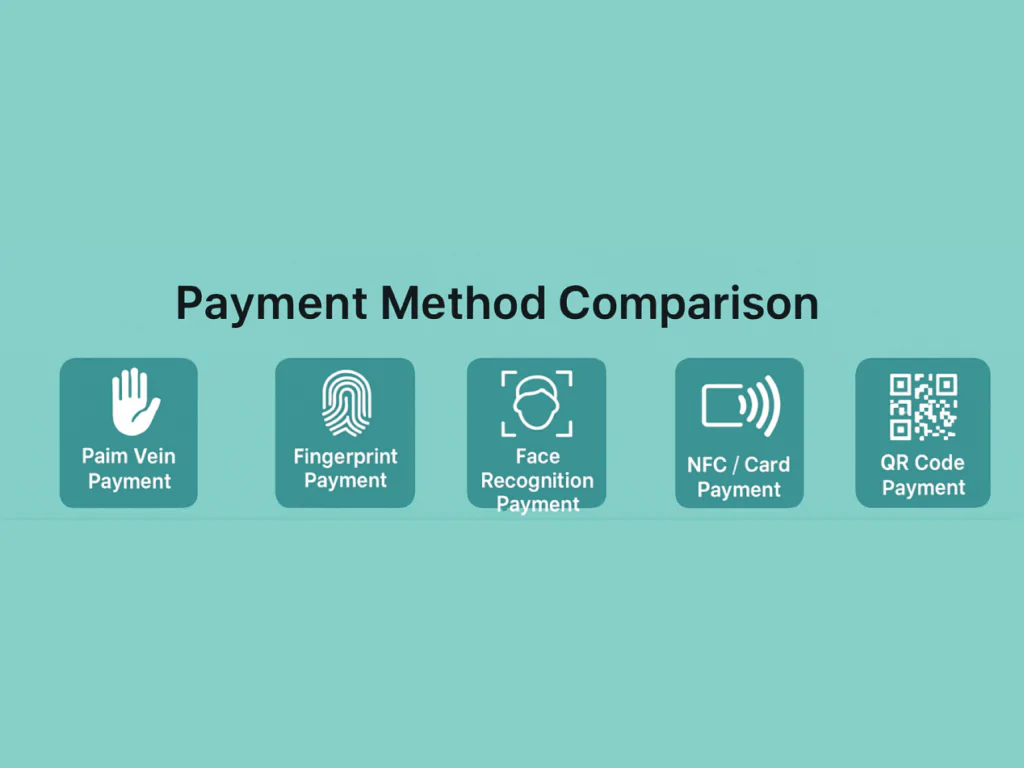Introduction
In the fast-evolving world of digital payments, security and convenience are no longer optional — they are essential. From fingerprint scanners to facial recognition, biometric payments have transformed the way we transact. Yet, each technology comes with its own limitations. So, what makes Palm Vein Payment the future of secure, contactless transactions?
1. True Contactless, Card-Free, and Phone-Free Payment
Unlike QR codes or NFC cards that require you to carry a phone, card, or enter a PIN, Palm Vein Payment works with just your hand.
Users simply hover their palm over the scanner — no physical contact, no device, no signature.
It’s the purest form of biometric convenience, making transactions seamless, hygienic, and fast.
2. Unmatched Biometric Stability
Palm vein patterns form beneath the skin and remain unchanged from age six for life.
Unlike fingerprints that can wear out or faces that change with age, lighting, or makeup, palm veins stay constant — ensuring lifelong reliability and accuracy.
This makes Palm Vein Authentication ideal for financial institutions, eKYC systems, healthcare, and government identity programs, where precision is critical.
3. Dual-Layer Recognition: RGB + IR for Maximum Accuracy
X-Telcom’s palm vein devices combine RGB surface imaging and infrared vein mapping, capturing over 5 million feature points.
The result:
- 0.35-second recognition speed
- 99% success rate in large-scale ID databases
- AI-driven liveness detection to prevent spoofing
This dual-layer fusion ensures every scan is genuine, secure, and verified in real time — a step far beyond traditional biometrics.
4. Superior Security and Privacy
Palm vein data is captured from inside the body, not from external features like fingerprints or facial images.
Because it requires blood flow, it’s impossible to fake or replicate.
All data is encrypted and stored as mathematical templates, ensuring zero exposure of personal images and meeting international banking security standards (EMV / PCI compliant).
5. Minimal Maintenance, Maximum Durability
Since palm vein recognition is fully touchless, there’s no sensor wear, no surface contamination, and no cleaning downtime.
This makes it ideal for high-traffic environments such as transport hubs, campuses, or retail payment points — reducing maintenance costs while extending hardware lifespan.
6. Comparison Snapshot
| Category | Palm Vein Payment | Fingerprint Payment | Face Recognition Payment | NFC / Card Payment | QR Code Payment |
|---|---|---|---|---|---|
| Biometric / Technology Type | Subcutaneous palm vein pattern (RGB + IR dual-mode) | Surface fingerprint ridge pattern | Facial geometric and texture features | Chip or contactless NFC module | 2D barcode (QR image) |
| Feature Extraction Principle | Extracts both IR vein patterns (subdermal blood vessel structure) and RGB palm texture — dual-layer biometric with 5M+ feature points | Extracts ridge endings and bifurcations (minutiae points), typically 40–80 points | Extracts distances and facial landmarks, typically 80–120 points | Reads chip or magnetic stripe data | Scans QR image linked to account |
| Need Phone, Card, PIN or Signature | ❌ No | ❌ No | ❌ No | ✅ Requires physical card, PIN or signature | ✅ Requires mobile phone |
| Contact Type | Fully contactless | Requires touch | Contactless (affected by lighting) | Contact or near-field tap | Scan printed or on-screen code |
| Anti-spoof Security | 🔒 Very high (internal veins, invisible and liveness-verified) | Medium (can be faked by printed or silicone fingerprint) | Low (photos or masks can spoof) | Medium (chip encryption) | Low (QR can be copied or intercepted) |
| Recognition Speed | ≈0.35 s | ≈0.5 s | ≈0.8 s | ≈1 s | 2–5 s |
| Environmental Impact | Not affected by light, humidity, or aging | Affected by skin dryness, cuts, dirt | Affected by lighting, angle, mask | Depends on terminal | Depends on network and brightness |
| Feature Stability | ✅ Stable after age 6; lifelong unchanged | ❌ Affected by skin condition, wear, and age | ❌ Changes with age, weight, or skin texture | ✅ Stable | ✅ Stable (depends on code generation) |
| Privacy Protection | Highest — internal biological data never exposed | Moderate | Low — external features easily captured | Moderate | Low |
| Maintenance Cost | Low (no contact, no wear) | High (sensor cleaning required) | Medium (camera calibration) | Medium | Low |
| Typical Applications | Banking, eKYC, healthcare, education, government | Mobile unlocking, access, attendance | Retail, public payment, gates | Bank payment, transport, retail | Mobile wallet, small vendors |
| Main Drawbacks | Higher hardware cost; SDK integration required | Hygiene issues, worn fingerprints | Unstable in poor lighting | Requires card handling | Requires smartphone and internet |
| Overall Evaluation | ✅ Most secure, contactless, and lifelong stable | 🔐 Mature but touch-based and wear-prone | ⚠️ Convenient but environment-sensitive | 💳 Traditional, widespread | 📱 Convenient but least secure |
Conclusion
Palm Vein Payment is not just another biometric option — it’s the next generation of secure, frictionless payment.
By combining AI-based RGB + IR recognition, contactless convenience, and lifelong stability, it delivers a superior user experience that outperforms all existing methods.
At X-Telcom, we are proud to lead this transformation with advanced Palm Vein solutions designed for banks, governments, and enterprises worldwide.
Learn more at https://x-telcom.com/palm-vein-reader/



